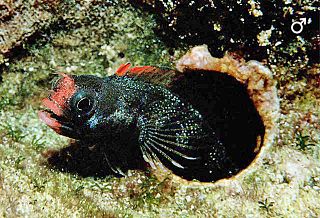
Citharichthys is a genus of flatfish in the large-tooth flounder family, Paralichthyidae. They have both eyes on the left sides of their heads. They are native to the oceans around the Americas, with a single species, C. stampflii off the West African coast. Most are found in relatively shallow depths, but the genus also includes species found in deep water and species that enter fresh water.

Enneanectes is a genus of triplefin fish in the family Tripterygiidae.
The Tayrona blenny is a species of chaenopsid blenny endemic to the Atlantic waters off of Santa Marta, Colombia.
Protemblemaria is a genus of chaenopsid blennies found in the eastern Pacific as well as the western Atlantic oceans.

Acanthemblemaria is a genus of chaenopsid blennies native to the Atlantic and Pacific Oceans.
Emblemaria is a genus of chaenopsid blennies found throughout the Pacific and Atlantic oceans.
Emblemariopsis bahamensis, the blackhead blenny, is a species of chaenopsid blenny found in coral reefs in the western Atlantic ocean. It and can reach a maximum length of 2.5 centimetres (0.98 in) TL.
Emblemariopsis bottomei, the Shorthead blenny or the Midnight blenny, is a species of chaenopsid blenny found in coral reefs in the western central Atlantic ocean. It can reach a maximum length of 3 centimetres (1.2 in) SL. The specific name honours Peter Bottome, although who this is, is not specified but it may possibly be the Venezuelan businessman Peter Bottome Deery (1937-2016).
Emblemariopsis dianae, the Orangeflag blenny, is a species of chaenopsid blenny found in coral reefs around Belize, in the western central Atlantic ocean. It can reach a maximum length of 2.1 centimetres (0.83 in) fish measurement. The specific name honours Diane M. Tyler, a researcher into the behavioural ecology of blennies in the family Chaenopsidae and the wife of James Chase Tyler.

Emblemariopsis diaphana, the glass blenny, is a species of chaenopsid blenny found in coral reefs in the Florida Keys, USA, in the western central Atlantic ocean. It can reach a maximum length of 4 centimetres (1.6 in) TL. The specific name refers to this species being "largely translucent" in life, although this is lost in preserved specimens. E. diaphana is the type species of the genus Emblemariopsis.
Emblemariopsis leptocirris is a species of chaenopsid blenny found in coral reefs in the western central Atlantic ocean.
Emblemariopsis occidentalis, the Flagfin blenny, Blackfin blenny or the Redspine blenny, is a species of chaenopsid blenny found around the Bahamas, Brazil, and the Lesser Antilles, in the western Atlantic ocean. Males of this species can reach a maximum length of 1.9 centimetres (0.75 in) SL, while females can reach a maximum length of 1.7 centimetres (0.67 in).
The seafan blenny is a species of chaenopsid blenny found in Glover's Reef, on the coasts of Belize and Honduras, in the western Atlantic ocean. It can reach a maximum length of 2.9 centimetres (1.1 in) SL. The specific name honours the premier of Belize at the time Greenfield was give permission to collect specimens in Bleize, George C. Price (1919-2011).
Emblemariopsis ramirezi is a species of chaenopsid blenny known from Venezuela, in the western central Atlantic ocean. The specific name honours Humberto Ramirez, who found this species and drew Cervigón's attention to it.
Emblemariopsis ruetzleri is a species of chaenopsid blenny found around Belize, in the western central Atlantic ocean. The specific name honours Klaus Ruetzler, Curator of Invertebrate Zoology at the National Museum of Natural History.

Emblemariopsis signifer is a species of chaenopsid blenny found in coral reefs in the western Atlantic ocean. It can reach a maximum length of 2.8 centimetres (1.1 in) SL. This species is preyed on by Horse-eye jacks.

Starksia is a genus of labrisomid blennies native to the western Atlantic Ocean and the eastern Pacific Ocean. Their typical length is 2 cm (0.79 in) SL. The generic name honours the American ichthyologist Edwin Chapin Starks (1867-1932) of Stanford University for his work on Pacific coastal fishes. As a genus Starksia is distinguished from other labrisomids by their scaled bodies, two obvious soft rays in the pelvic fin and the male's have an intromittent organ which is near to or attached to the first spine of their anal fins, which is also somewhat separated from the fin.
Emblemariopsis arawak, the Araw glass blenny, is a species of chaenopsid blenny known from tropical reefs in the Caribbean Sea. This species can reach a length of 1.1 centimetres (0.43 in) SL.

The Caribbean flagfin blenny is a species of chaenopsid blenny known from tropical reefs in Puerto Rico and the Virgin Islands, in the Caribbean Sea. This species reaches a length of 1.5 centimetres (0.59 in) SL.
Coryphopterus is a genus of gobies primarily found in the western Atlantic Ocean, although some species are found in the Indian and/or Pacific oceans.







